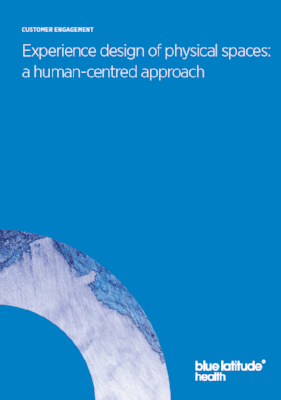Experience design of physical spaces: a human-centred approach
May 25, 2016 | Customer Experience, physical space design, spatial design, user experience design, user-centric design, wayfinding
Anna Tamasi from Blue Latitude Health highlights the key considerations and best practices for spatial design from a user experience design perspective.
Good user experience (UX) design considers how people feel about products and services and caters for their needs – and space design works exactly the same way. Experience design is all about people’s needs; making products and services useful and usable as well as aesthetically pleasing at the same time. It’s also about integrating technology that supports functionality and convenience for people.
When we design for physical spaces, we need to consider where and how people spend their time, what activities they do within that space, and the sequence in which they do them. Colours, textures, ambience design (lighting, music, etc.), and ergonomics are also integral parts of the space design process.
In this article, Consultant Anna Tamasi highlights the key considerations and best practices for spatial design from a user experience design perspective.
What does UX have to do with spatial design?
To ensure people feel good in physical spaces, UX designers need a variety of skills; experience design, service design, ergonomics and preferably architectural design skills (like interior design). These disciplines share similar methods and approaches – even their deliverables are alike.
In UX, designers create wireframes to display the layout of a website or an app, as well as to show features and interactivity. In architecture, floor plans are produced to map out the space and to show the flow of activities and movements in addition to indicating furniture layout. Architects and interior designers produce mood boards; UX designers create mock-ups to communicate the vision of the product, and so on.
Success factors: The human-centred design approach
Translating brand ideas, stories, and customer journeys into three dimensions requires a systematic design process. You need to follow certain principles and apply a range of techniques; we call this the ‘human-centred design process’ in UX, where people are the heart of the design process. Human-centred design is a creative problem-solving approach in which we build empathy with people we’re designing for. Therefore, the following points focus on people rather than technical implementations.
1. Design for simple and engaging experiencesWe have to remember that people always enter space with different intents, goals, and mindsets. Some people will be willing to engage more, whilst others will just pass through the space. In order to engage with as many visitors as possible, you need to design for experiences that are short but impactful. Experiences that reward longer interactions but do not require them will result in deeper engagements from your visitors.
If you design a congress booth, for example, you should design for various levels of engagement. Offer incentives for those who are willing to interact with your space longer, but impress the ones passing by so they can also leave with a memorable experience.
2. Provide intuitive navigation through space
When designing for physical space, you need to remember that wayfinding is nothing more than a structured number of decisions leading to the destination. Therefore, it is crucial to create systematised pathways with simple and consistent navigational choices that are easily recognisable by everyone.
Visiting a hospital can be a stressful experience. Intuitive wayfinding tools are key components for improving this experience (i.e. landmarks, walking directions and paths, as well as intuitive icons, symbols, and terminology). Wayfinding encompasses all aspects of knowing where you are and successfully navigating to your destination.

Download the full article from Blue Latitude Health
This content was provided by Blue Latitude Health




